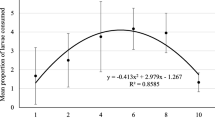Abstract
It is shown that there are a number of factors that are important to consider when planning the experiments on studying the trophic parameters of the caterpillars of the Gypsy moth, first of all, the population characteristics of the species including the sex and age structure that change annually. The final results of the study are also influenced by some procedures during the experiments, particularly, the duration (especially in the longest instars of the caterpillars) and volume of the sampling, which is supposed to grow as the caterpillars instar increases. The expediency is examined for using the individual growing of the caterpillars to study the species nutrition.
Similar content being viewed by others
References
P. Barbosa and J. Greenblatt, “Suitability, Digestibility and Assimilation of Various Host Plants of the Gypsy Moth Lymantria dispar L.,” Oecologia 43(1), 111 (1979).
T. A. Vshivkova, “Ecological-Physiological Parameters of Growth of Caterpillars of Gypsy Moth on Basic Host Plants in Siberia,” in Role of Relationships Plant-Insect in the Dynamics of Number of Forest Pests (Krasnoyarsk, 1983), pp. 126–137 [in Russian].
Yu. N. Baranchikov, Trophic Specialization of Lepidopterans (Krasnoyarsk, 1987) [in Russian].
Sh.-Y. Hwang and R. L. Lindroth, “Clonal Variation in Foliar Chemistry of Aspen: Effect on Gypsy Moths and Forest Tent Caterpillars,” Oecologia 111, 99 (1997).
J. Lazarevic, V. Peric-Mataruga, B. Stojkovic, and N. Tucic, “Adaptation of the Gypsy Moth to an Unsuitable Host Plant,” Entomol. Exp. et Appl. 102, 75 (2002).
E. M. Andreeva, V. I. Ponomarev, and N. V. Shatalin, “Morphophysiological and Trophic Characteristics of Caterpillars of Gypsy Moth (Lymantria dispar L.) of Two Populations Depending on Hydrothermal Conditions and Population Density,” Entomologicheskoe Obozrenie 86(3), 503 (2008).
E. M. Andreeva, “Trophic Aspects of Ecology of Gypsy Moth (Lymantria dispar L.),” Candidate’s Dissertation in Biology (Yekaterinburg, 2002).
M.W. Henn and R. Schopf, “Response of Beech (Fagus sylvatica) to Elevated CO2 and N: Influence on Larval Performance of the Gypsy Moth Lymantria dispar (Lep., Lymantriidae),” J. Appl. Ent. 125, 501 (2001).
A. V. Il’inykh, “Optimized Artificial Nutritional Medium for Growth of the Gypsy Moth (Ocneria dispar L.),” Biotekhnologiya, No. 1, 42 (1996).
G. P. Waldbauer, “The Consumption and Utilization of Food by Insects,” Adv. Insect. Physiol. 5, 229 (1968).
E. M. Andreeva, “On Duration of Development of Larval Instars, Caterpillar Stage and Weight of Pupae of the Gypsy Moth during Depression,” in Entomological Studies in West Siberia. Proceedings by Kemerovo Division of Russian Entomological Society (Yuniti, Kemerovo, 2008), Issue 6, pp. 3–10 [in Russian].
N. M. Edel’man, “Biology of the Gypsy Moth in Quba Rayon of Azerbaijan SSR,” Zoologicheskii Zh. 35(4), 572 (1956).
I. M. Kireeva, Ecology and Physiology of the Gypsy Moth (Naukova Dumka, Kiev, 1983) [in Russian].
A. I. Il’inskii, Gypsy Moth and How to Fight It (Goslesbumizdat, Moscow, 1959) [in Russian].
N. Carisey and E. Bauce, “Impact of Balsam Fir Flowering on Pollen and Foliage Biochemistry in Relation to Spruce Budworm Growth, Development, and Food Utilization,” Entomol. Exp. et Appl. 85, 17 (1997).
T. L. Osier and R. L. Lindroth, “Long-Term Effects of Defoliation on Quaking Aspen in Relation to Genotype and Nutrient Availability: Plant Growth, Phytochemistry, and Insect Performance,” Oecologia 139, 55 (2004).
D. E. Leonard, “Effects of Starvation on Behavior Number of Larval Instars, and Developmental Rate of Porthetria Dispar,” J. Insect Physiol. 16, 25 (1970).
T. A. Vshivkova, “Analysis of Growth and Development of Caterpillars from Two Isolated Populations of the Gypsy Moth,” in Gypsy Moth in Central and East Siberia (Novosibirsk, 1982), pp. 35–42 [in Russian].
S. Nagasawa, “Nubmer of Larval Instars of the Gypsy Moth in Japan (Lepidoptera: Lymantriidae),” Appl. Entomol. Zool. 23(4), 441 (1988).
B. A. Stockhoff, “Diet Heterogeneity: Implications for Growth of a Generalist Herbivore, the Gypsy Moth,” Ecology 74(7), 1939 (1993).
K. K. Kinney, R. L. Lindroth, S. M. Jung, and E.V. Nordheim, “Effects of CO2 and NO3 — Availability on Deciduous Trees: Phytochemistry and Insect Performance,” Ecology 78(1), 215 (1997).
R. L. Lindroth, K. A. Klein, J. D. C. Hemming, and A. M. Feuker, “Variation in Temperature and Dietary Nitrogen Affect Performance of the Gypsy Moth (Lymantria dispar L.),” Physiol. Entomol. 22(1), 55 (1997).
J. Lazarevic, V. Peric-Mataruga, J. Ivanovic, and M. Andjelkovic, “Host Plant on the Genetic Variation and Correlation in the Individual Performance of the Gypsy Moth,” Functional Ecol., No. 12, 141 (1998).
Author information
Authors and Affiliations
Corresponding author
Additional information
Original Russian Text © E.M. Andreeva, 2012, published in Sibirskii Ekologicheskii Zhurnal, 2012, Vol. 19, No. 1, pp. 57–64.
Rights and permissions
About this article
Cite this article
Andreeva, E.M. Certain methodical aspects of experiments studying the nutrition of caterpillars of the Gypsy moth. Contemp. Probl. Ecol. 5, 40–45 (2012). https://doi.org/10.1134/S1995425512010055
Published:
Issue Date:
DOI: https://doi.org/10.1134/S1995425512010055




